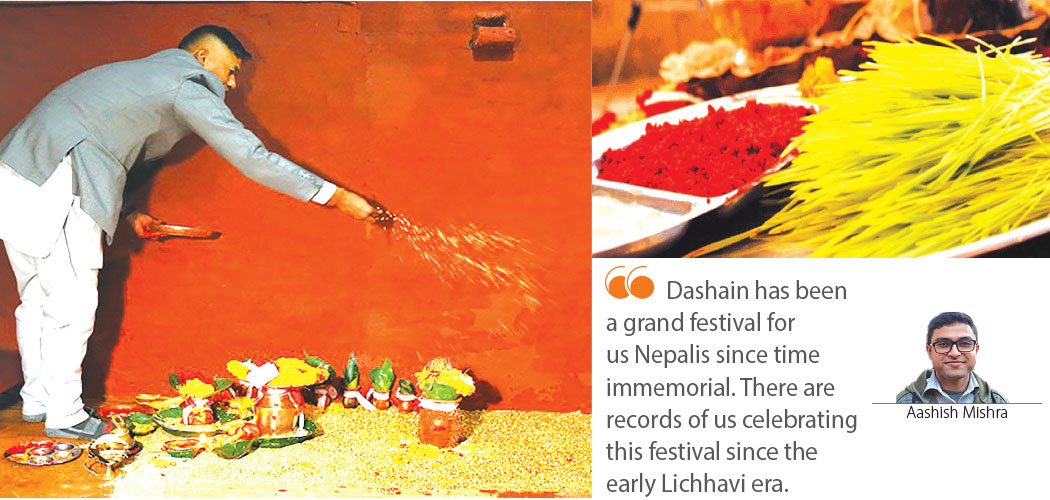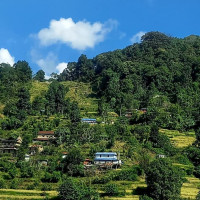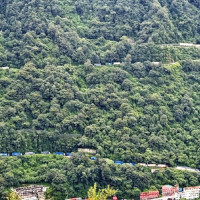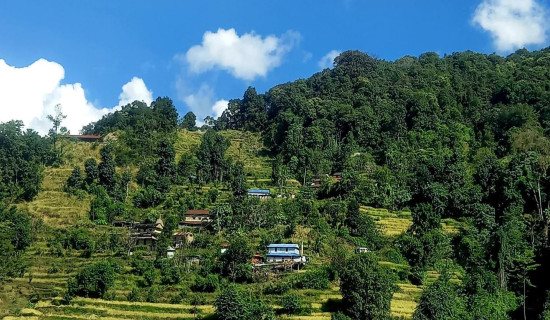- Tuesday, 11 November 2025
The Dashain We've Lost
If this scribe had a rupee for every time he heard someone sigh, "Dashain doesn't feel the same anymore," he would probably be a millionaire by now.
If you're above a certain age, it almost seems mandatory to complain that Dashain has lost its charm — and perhaps, for you, it has. Everything feels bigger and brighter in childhood. Once you're no longer a child, it's natural for festivals to feel less magical.
But not everything can be explained away as nostalgia. There are certain elements we have genuinely lost, elements that, in this writer's opinion, made Dashain better. Of course, he himself says this as a wrinkly old millennial, but still, hear him out and see if you agree.
Dashain weather
Perhaps the biggest thing we have lost is the special Dashain weather. The sun bright but forgiving, the breeze crisp and slightly cool, making you reach for a shawl but not a sweater, the sky bright blue. The summer heat faded and the monsoon clouds parted to give you to Autumn's embrace. And it really was an embrace. The Dashain air felt like a hug.
Sadly, that is no longer the case. These days, Dashain swings between punishing heat or rains that leave the ground heavy and muddy.
Until a few decades ago, one could tell that Dashain was on the horizon by looking out the window. Now, though, climate change has robbed us of that pleasure.
True leisure
Dashain used to be a time to relax and enjoy with family. It used to be a holiday in the truest sense. Whether you were a civil servant or a corporate serf, you got around a week off to celebrate. Everything wound down from Phulpati to a few days after Vijaya Dashami.
But now, Dashain holidays are starting to turn into a luxury. Offices are starting to demand that their employees work during the festival.
One now has to 'justify' their request for time off during Dashain. Yes, you read that right. The hustle culture of today does not consider the biggest festival of the country as reason enough to warrant five days off. You now have to fulfil additional criteria.
"I need to travel outside the Valley."
"Be back the day after Tika."
"My relatives are visiting from abroad. I want to spend time with them."
"Take your files with you and work from home."
Furthermore, many that do take time off for Dashain often have to compensate for it by working during Tihar. So, it's a choice between being with your family for the most significant occasion of the year or the second-largest occasion. You can't have both.
This is why villages don't come alive during Dashain like they used to and cities remain crowded.
Family gatherings
Dashain used to be a time of family gatherings. Siblings, cousins, grandparents – the whole extended family got together and enjoyed each other's company. But people have now started treating Dashain holidays as vacations rather than celebrations.
They go on trips, catch up on pending tasks, or laze around. Youngsters, in particular, view family meets as chores rather than occasions to look forward to.
Khadgasthapana
This is not a tradition we have truly lost, but rather one we have forgotten by name. Families and communities across Nepal Mandala still perform this ritual, but many do not know that it's called Khadgasthapana.
In fact, try it yourself. Mention 'Khadgasthapana' to a friend or family member and see if they know what it means. Undoubtedly, they will first think you've mispronounced Ghatasthapana.
Khadgasthapana is a tradition that reflects the ancient military dimension of Dashain. Newa families and clans who hold the ceremonial Khadga swords consecrate them in their 'Dashain Rooms' on Dashain's eighth day (i.e., Maha Ashtamai).
The weapon remains there for two days to 'charge.' On the 10th day (i.e. Vijaya Dashami), the Khadga is taken out of the special room and wielded by specially designated people around a specific area. This ritual is referred to as 'Khadgachaalan' or simply 'Chaalan' in Sanskrit. The Nepal Bhasa word for Vijaya Dashami, 'Chālaṁ', is a corruption of this Sanskrit name.
This is a tradition that may very well be present in other Chhetri or warrior communities in Nepal. However, since this columnist is a native of Kathmandu Valley, he is only familiar with the Newa version of this practice.
And speaking of Chālaṁ, not many are aware that the merchant families of Ason, Kathmandu, celebrate their Khadgachaalan/Dashami/Tika a day after the rest of the country. That is because, as businesspeople living at the centre of a bustling marketplace, they could not afford to close their stores on one of the biggest shopping days of the calendar year. Some tales say that their customers did not used to allow them to shutter their shops.
So, as traders, they keep their own celebration on hold, allowing the rest of us to celebrate Vijaya Dashami on Dashami itself, while they mark it a day later.
Dashain has been a grand festival for us Nepalis since time immemorial. There are records of us celebrating this festival since the early Lichhavi era. However, with every passing year, it seems that the grandeur of this significant religious, cultural and social observance is growing thinner, like an old cloth fraying at the edges. In this penman's 29 years on this planet, he has already so much slip away. The kites, the swings, the lazy rhythm of true leisure, even the very air of Dashain – nothing is as he remembers from his childhood.
If so much can be lost in less than half a lifetime, what will the next 29 years take from us? Perhaps, by the time of our children or grandchildren, we may still be having feasts, still be accepting Tikas and blessings from our elders, and still call it Dashain, but only have a hollow echo of what it once was. And if that day comes, we may realise too late that we have not only lost rituals and traditions but have lost a part of our souls too.
(Mishra is a storyteller, cultural researcher and communication professional.)






-original-thumb.jpg)







